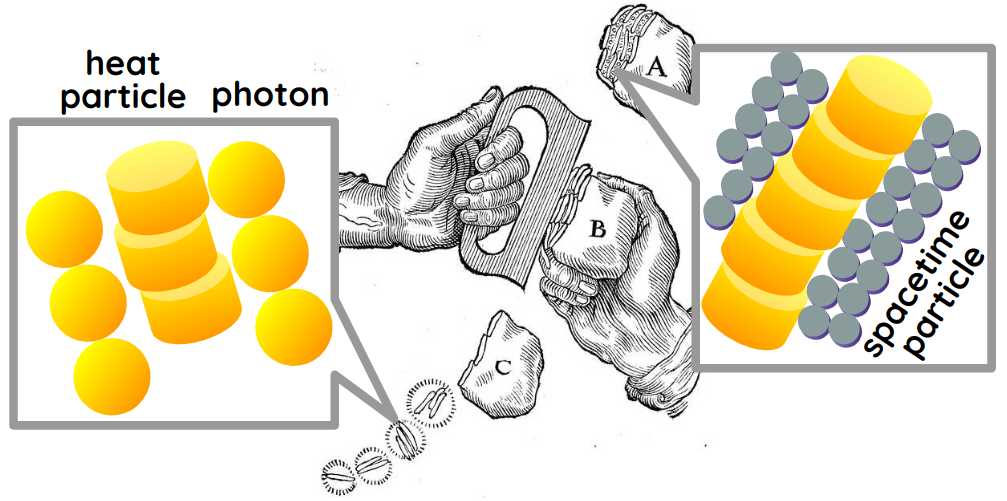The Nature of Fire
Table of Contents
Superphysics Note
80. The nature of fire and its distinction from air
How can flame be ignited in these cavities? What is the nature of fire?
The earth-aether, regardless of their size or shape, take the form of fire when they are separated from one another.
Thus, they get surrounded by the fire-aether and must follow their course, just as they take on the form of air when floating among the air-aether globules, imitating their movement.
Therefore, the primary and principal difference between physical air and fire is that fire particles move faster than air particles
- This is consistent with the fire-aether being more agitated than the-aether.
The secondary difference is that:
- the largest parts of earth-aether bodies can best preserve and nourish fire.
- the smallest particles of earth-aether can best retain the form of air.
The largest earth-aether, like quicksilver, can also receive the air-aether when they are very agitated by heat.
- But they lose it afterwards when this agitation diminishes.
- This makes them descebd due to gravity.
81. How fire is first ignited
The air-aether globules:
- occupy all the spaces around the earth-aether large enough to contain them.
- are so crowded there that they touch each other and support each other
- If one moves, its neighbors also move unless that motion was a rotation
The fire-aether fills all the gaps left by these globules and moves very rapidly within them.
- But these still cannot carry the earth-aether particles with them because they are surrounded by the air-aether
To generate fire, the air-aether globules must be expelled from the gaps between some earth-aether particles.
This frees up the earth-aether particles to follow the fire-aether in various directions.
82. How is Fire Sustained?
To sustain this fire, the earth-aether particles must be dense, solid, and apt for motion.
This will allow it to move and give it force as directed by the fire-aether to repel the air-aether which constantly pushes them to return to the place of the fire from which they were expelled.
- This prevents the fire from being extinguished by joining the others again.
83. Why Does Fire Need Nourishment?
Through the fire, the earth-aether goes into the air where they lose their agitation little by little.
- This makes them cease having the form of fire and turn to smoke.
This is why fire cannot remain long in the same place unless there is some body that it successively consumes to maintain itself.
Such a body should be:
- separable one after the other by the action of the fire which then changes them into smoke.
- plentiful and large enough to have the strength to repel the air-aether which tend to suffocate this fire
- The earth-aether in the physical air is not enough for this.
84. How Is Fire Sparked from Flint?
Flints are hard, rigid, and friable.
Because of their hardness and rigidity, when struck by a hard body, the spaces between many of their particles, usually occupied by air-aether globules, become narrower.
These air-aether are compelled to spring out. They leave only the fire-aether around them.
Due to their friability, once these particles of flint are no longer pressed by the impact, they spring apart. The fire-aether, found solely around them, composes the fire.
Ais flint with visible air-aether globules in its anterior particlesBis the same flint when struck by a hard body. Its channels have become narrower, leaving only the fire-aether.Cshows the same flint already struck, with some particles separated and having only the fire-aether around them, resulting in sparks of fire.

85. How is Fire Produced from Dry Woods?
Wood will not emit sparks if struck because it is less hard.
The first part of it that encounters the striking body bends toward the second part. That second part then bends toward the third part.
Thus, the air-aether globules do not leave their intervals simultaneously.
Instead, they depart successively, sometimes from one, sometimes from another.
However, if the wood is rubbed vigorously for a long time, the friction causes unequal agitation and vibration of its particles. This can shake loose the air-aether globules, separating them from each other. This action then transforms them into fire.
86. How is Fire Produced from the Collection of Sunbeams?
Fire can also be ignited by directing many sunbeams through a concave mirror or convex glass onto a particular spot.
The action of these sunbeams has globules of the air-aether as their substrate. It is much more vigorous than the usual motion of these globules.
Since it originates from the fire-aether of the Sun, it has sufficient speed to ignite fire.
Additionally, so many rays can be focused at the same time that they have enough force to agitate terrestrial particles with the same speed.